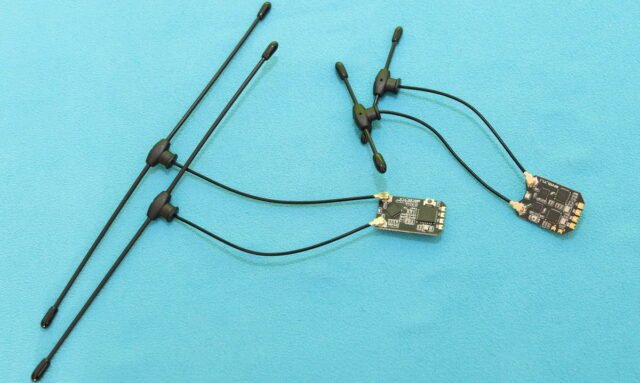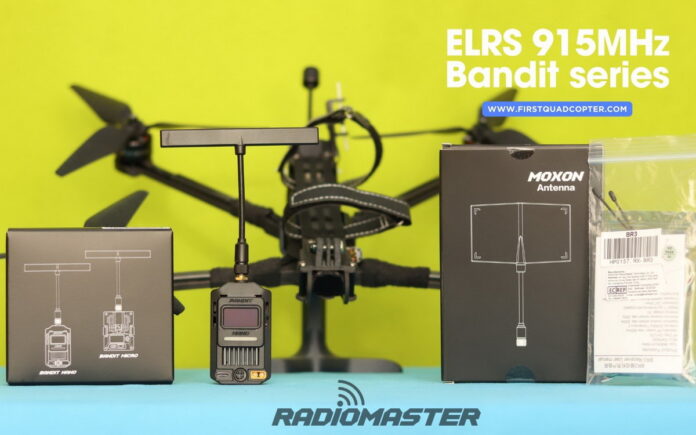After testing so much 2.4GHZ ELRS hardware, I thought it was time to review some 915MHz equipment too. RadioMaster’s Bandit series includes three TX units (RF, Micro, and NANO) and two RX modules (BR1 and BR3). In this article, we will check out the features and how to set up the Bandit Nano transmitter module and BR3 radio receiver.
ExpressLRS works on 2.4Ghz and 900Mhz frequencies; the furthest we’ve seen it tested was 40km using 900Mhz at just 10mW -Leslie Yagin’s range test video can be seen here. On ExpressELS is a table with the distances testers have reached with different power settings. With up to 1W transmission power, the Bandit Nano is among the most powerful 915Mhz ELRS TX modules.
When you compare 915Mhz to 2.4GHz ELRS radio systems, it is not about the best but the frequency that fits your needs more. The 915MHz version of ExpressLRS runs at a maximum 200Hz update rate, higher than Crossfire’s 150Hz. In contrast, the 2.4GHz ELRS can even run at 1000Hz! 2.4GHz gives enough range for most people and has a wider bandwidth, allowing more people to fly simultaneously. The antennas (RX/TX) are also much smaller for 2.4GHz than for 915Mhz.

On the other hand, if you favor range and signal penetration and don’t care about the mentioned advantages, go with 915MHz. The lower frequency ELRS is less prone to interference with WIFI equipment and digital VTXs. Here, I should note that there are no dual-band TX/RX modules, and you can’t mix 915Mhz RX with 2.4Ghz TX or vice versa.
The Bandit Nano ExpressLRS 915MHz TX Module is designed for a nano-size module bay. It fits perfectly in smaller radios such as the RadioMaster Zorro/Pocket, Jumper T-lite/T14/T20, Frsky X-Lite, and TBS Tango 2. However, using a Nano-Micro adapter, you can use this module in bigger radios with standard JR module bay, such as the RadioMaster TX16S/Boxer and Frsky X9D-Plus.
RadioMaster Bandit Nano ELRS TX and Bandit BR3 ELRS RX review
I received these ELRS 915MHz modules for a product review collaboration with RadioMaster. Specs and quality may vary according to the manufacturer’s reliability, so I cannot guarantee that you will get products that perform the same as seen in my review.
RadioMaster is a team of radio control model enthusiasts with a long history in the RC industry. The company has two ExpressLRS product ranges, the Ranger (2.4GHz) and Bandit (915 MHz).
Last month, RadioMaster sent me together with the ISDT 608PD charger, a Bandit Nano TX ExpressLRS 915MHz RF Module, a Bandit BR3 RX ExpressLRS 915MHz Receiver, and a Bandit 915/868MHz Moxon Antenna. They also wanted to send the Bandit BR1, but it was out of stock then.
1. Bandit Nano ExpressLRS 915MHz 1W RF TX
First, I opened the Bandit Nano TX’s box. It comes packed with a T-type antenna with 2.7dBi gain and a quick start guide. The unit measures 68.5*41*270mm and weighs 62.5 grams, including the antenna. If you need higher performance, you can replace the stock antenna with the high-gain, high-efficiency RadioMaster MOXON directional antenna. The Bandit Moxon antenna, with its increased surface and 4.6 dBi gain, provides superior interference separation.
The RM Bandit Nano’s case is made from aluminum, allowing improved heat dissipation. When high output power is selected, the built-in fan is activated. The front panel has an OLED status screen, a Type-C port, an XT30 power connector, and a 5D control joystick. Through the XT30, you can power the unit from 6V to 16.8V (2S-4S LIPO battery).

Inside, the PCB has UART solder pods, allowing the module to be used as a high telemetry power receiver.
In addition to the ESP32 main SOC, it has an ESP8285 for ELRS Backpack. The ESP32 is a high-performance standalone system that provides Wi-Fi and Bluetooth connectivity. The firmware on the Bandit Nano TX can be flashed conveniently via WiFI. Remember that after upgrading the ELRS firmware, you must also update the LUA script on the radio controller.

Bandit Nano 915MHz ELRS: Key features
- Up to 1-watt power output
- Packet rates up to 200Hz
- Optimized circuitry for ultra-low power consumption
- Built-in TCXO oscillator
- High contrast OLED display and 5 Directional navigation key
- High-efficiency cooling system
- Wifi and Bluetooth wireless connectivity
- ExpressLRS 3.3.1 stock firmware
- Built-in ExpressLRS backpack
- 915/868MHz T Antenna included
- Nano connector, support Zorro, Pocket, and MT12 radio controller
Bandit Nano 915MHz 1W ELRS: Technical parameters
| Regulatory Domain | FCC915 |
| MCU | Main: ESP32 Aux as ESP backpack: ESP8285 |
| RF Chip | SEMTECH SX1276 |
| Refresh Rate | Min/Max: 25Hz/200Hz |
| RF Output Power | 1000mW/30dBm |
| Bay compatibility | Nano with 8-pin connector |
| External power | XT30 DC 6V ~ 16.8V |
| Dimension | 68.5*41.0*27.0mm |
| Weight | 62.5grams (with T antenna) |
2. Bandit BR3 ExpressLRS 915MHz Receiver
The RM BR3 radio receiver measures 24*14.2mm and weighs 5.5 grams (including antennas). The tiny modules use two 915/868MHz T antennas connected to the PCB through IPEX connectors. Besides the two antennas, RadioMaster provides three transparent shrink tubes and FC wires with the BR3.

Featuring two ESP8285 MCUs, I expect diversity and ELRS GEMINI capabilities. The BR3 RX uses a temperature-compensated crystal oscillator (TCXO) for improved stability. Telemetry (feedback) power can be adjusted from 100-500mW via LUA script. The tiny module has a CRSF interface with four solder pins (GND, 5V, RX, TX). When you wire it to the flight controller, remember that RX goes to TX, respectively TX to RX.
Radio Master Bandit BR3 RX also supports two ways to flash ExpressLRS firmware: via WiFi or ExpressLRS Configurator (BetaFlight passthrough). In WIFI mode, you must connect to the TX’s hotspot using “expresslrs” password. You must plug/unplug the RX’s power three times to enter bind (pairing) mode.
Bandit BR3 ELRS RX: Key features
- Maximum 500mW telemetry RF power
- Built-in TCXO oscillator
- Utilizing 0402 components, superior resistance to vibration
- Dual 915/868MHz T Antenna for improved signal stability and range
Bandit BR3 ELRS RX: Technical parameters
| Regulatory Domain | FCC915 |
| MCU | 2x ESP8285 |
| RF Chip | SEMTECH SX1276 |
| Oscillator | TCXO |
| Telemetry RF power | 100-500mW (adjustable via LUA script) |
| Antenna | 2x IPEX1 915/868MHz T-type |
| Bus Interface | CRSF |
| Working voltage | DC 5.0V |
| Dimension | 24*14.2mm |
| Weight | 5.5 grams (including antennas) |
Pricing and availability
All RadioMaster Bandit products can be purchased from the manufacturer’s store and popular RC retailers. The 915Mhz ELRS TX module costs $49.99, and the BR3 RX module is $24.99. The 915/868MHz Moxon Antenna is available for $19.99 if you need the best signal coverage.
RadioMaster Bandit 915MHz: Alternatives
While all ELRS RX modules, regardless of brand, use the same CPU and RF chip, the TX modules may offer different features. Some TX modules have external power source options, and some have active cooling to handle high transmission powers. For easier configuration, premium TX units like the Bandit Nano can even have a built-in OLED display.
One advantage of the RadioMaster Bandit Nano ExpressLRS is the maximum 1000mW output power, as most of its contenders, including the BetaFPV Nano TX module, can only do up to 500mW.
When looking for a Nano 916MHz ELRS TX, the Emax Aeris Link can also be a great option -it is priced at just $38.99 and has similar features to the RM Bandit.
You Can Trust Our Reviews!
Since 2014, FirstQuadcopter has reviewed, thoroughly tested, and rated hundreds of products, including drones, gimbals, power stations, action cameras, 3D printers, and other high-tech gear to help you make better buying decisions.






What is the farthest distance you can achieve with the 915MHZ Bandit NANO TX and the BR03 RX at 500mW?
Range is depends on many factors, but you can probably fly further than you FPV signal